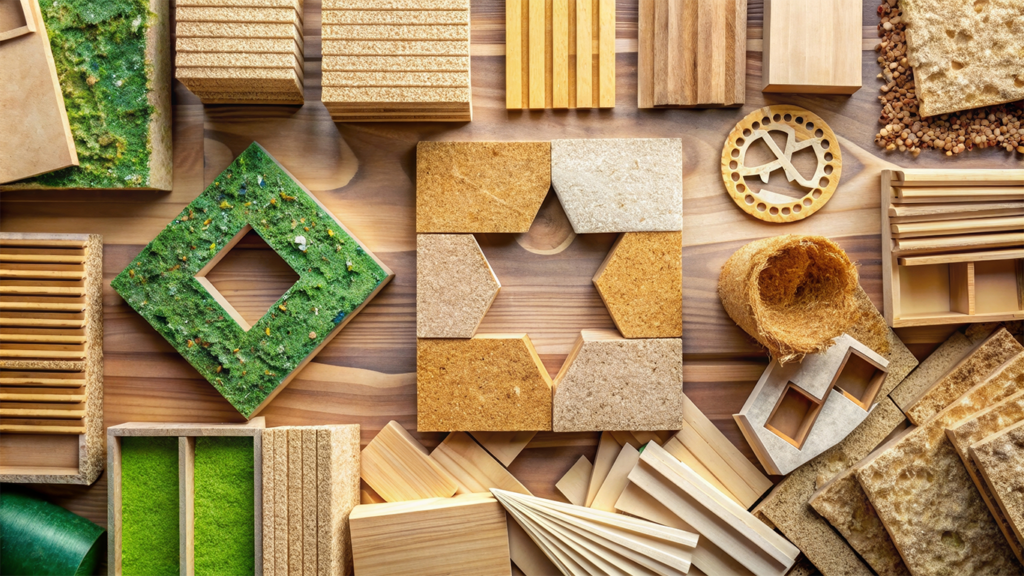For decades, the construction industry has been a major contributor to global carbon emissions, resource depletion, and waste. But a quiet revolution is underway, transforming the very fabric of our buildings. Today, a growing number of homeowners, architects, and builders are turning to sustainable building materials—not just as a niche trend, but as a smarter, healthier, and more responsible way to build.
Moving beyond the classic “reduce, reuse, recycle” mantra, this new wave of materials is about innovation, performance, and reconnecting with nature. If you’re planning a renovation, building a new home, or are simply curious about the future of living spaces, here are the sustainable materials capturing everyone’s interest.
1. Mass Timber: The High-Rise Wonder Wood
Forget the weak wood structures of the past. Mass Timber, particularly Cross-Laminated Timber (CLT), is engineered for strength. It involves layering wood panels at right angles and bonding them with structural adhesives, creating slabs and panels that rival the strength of concrete and steel.
Why It’s Interesting: It’s a powerful tool in fighting climate change. Trees absorb carbon dioxide as they grow, and that carbon is sequestered (stored) within the building’s structure for its entire lifespan. This makes mass timber buildings potential “carbon sinks.” Additionally, it’s prefabricated off-site, leading to faster, quieter, and less wasteful construction.
Ideal For: Structural frames, walls, floors, and roofs in everything from single-family homes to modern mid-rise offices and apartments.
2. Hempcrete: The Breathable Insulator
No, you can’t get high from your walls. Hempcrete is a biocomposite material made from the inner woody core of the hemp plant (hurd) mixed with a lime-based binder. The result is a lightweight, cement-like material used for insulation and walling.
Why It’s Interesting: It’s incredibly sustainable. Hemp grows rapidly, requires very little water, and no pesticides. It also improves soil health. As a building material, it’s non-toxic, mold-resistant, and highly breathable, regulating indoor humidity and creating excellent air quality. It’s also fire and pest resistant.
Ideal For: Non-load-bearing insulation, wall infill in timber frame construction, and renovation projects where breathability is key to preventing damp.

3. Mycelium: The Future of Foam from Fungi
Perhaps the most futuristic material on the list, mycelium is the root structure of mushrooms. By growing mycelium around agricultural waste (like corn stalks or wood chips) in molded forms, companies can create strong, lightweight, and fully compostable building materials.
Why It’s Interesting: It’s the epitome of “growing” a material with almost zero waste. It uses a biological process instead of an energy-intensive industrial one. After its useful life, the product can be broken down and returned to the earth. Currently, it’s being developed for insulation, acoustic panels, and even decorative tiles.
Ideal For: A glimpse into the future! Currently used for specialty insulation, packaging, and acoustic products, with potential for much more.
4. Recycled Steel: The Circular Economy Champion
Steel production is notoriously energy-intensive. However, recycled steel changes the game. Steel is 100% recyclable without any loss of quality. Using recycled content significantly reduces the energy required compared to producing new steel from iron ore.
Why It’s Interesting: It’s a proven, strong, and reliable material that fits perfectly into a circular economy. Choosing a structural frame made from recycled steel ensures incredible durability and resilience (especially in areas prone to fires or earthquakes) while drastically cutting the environmental footprint.
Ideal For: Structural frames, roofing, and facades. It’s a mainstream material with a powerful green upgrade.
5. Reclaimed and Recycled Wood: Beauty with a Story
There’s a reason reclaimed wood remains perennially popular. Sourced from old barns, factories, retired shipping crates, and even salvaged from riverbeds, this wood carries a unique history and character that new lumber can’t match.
Why It’s Interesting: It prevents perfectly good wood from ending up in landfills and reduces the demand for newly logged timber. Each plank has a unique patina, nail marks, and a story. It’s a direct connection to the past that adds warmth and authenticity to any space.
Ideal For: Flooring, accent walls, beams, and custom furniture. It’s the ultimate blend of sustainability and style.
6. Rammed Earth: Ancient Technique, Modern Appeal
One of the oldest building methods is making a major comeback. Rammed earth involves compacting a damp mixture of earth (containing sand, gravel, clay, and sometimes a stabilizer like lime) into forms to create solid, thick walls.
Why It’s Interesting: It has a stunning, layered, aesthetic appeal that is entirely unique. Its high thermal mass absorbs heat during the day and releases it at night, naturally regulating indoor temperatures and slashing energy bills. It’s made from locally sourced, abundant material, minimizing transportation.
Ideal For: Load-bearing walls in dry, temperate climates. It creates a modern, minimalist look with deep organic roots.
Why the Buzz? It’s More Than Just “Green”
The interest in these materials isn’t just about saving the planet—though that’s a huge driver. It’s also about:
Healthier Living: Many conventional building materials emit VOCs (Volatile Organic Compounds) that can off-gas for years, polluting indoor air. Sustainable materials like hempcrete, clay plasters, and natural wood finishes are non-toxic and promote better indoor air quality.
Energy Efficiency: Materials with high thermal mass (like rammed earth) or superior insulating properties (like hempcrete) create a more stable indoor environment, dramatically reducing the need for heating and cooling.
Durability and Resilience: Many of these materials are incredibly durable and resistant to fire, pests, and moisture, leading to longer-lasting buildings and lower maintenance costs.
Aesthetic Uniqueness: People crave homes with character and a story. Reclaimed wood, rammed earth walls, and handmade tiles offer a beauty that drywall and vinyl cannot replicate.
Building Your Future
The next time you imagine your dream home, consider the walls themselves. By choosing sustainable materials, you’re not just constructing a building—you’re investing in your health, your wallet, and the planet’s future. It’s a powerful way to ensure that the place you call home is in harmony with the world outside your door.

